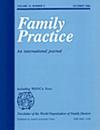Can patient education initiatives in primary care increase patient knowledge of appropriate antibiotic use and decrease expectations for unnecessary antibiotic prescriptions?
IF 2.4
4区 医学
Q1 MEDICINE, GENERAL & INTERNAL
引用次数: 0
Abstract
BACKGROUND Healthcare globally is increasingly threatened by antibiotic resistance. Misunderstanding of the appropriate use of antibiotics is common within the general population, therefore patient education could be a useful tool to employ against antibiotic resistance. Patient satisfaction with healthcare is important, and antibiotic awareness is crucial to avoid disappointment when antibiotic stewardship is practiced. AIM This review aims to identify whether patient education is an effective tool to improve knowledge and awareness of the appropriate use of antibiotics and whether it has an effect on expectations of or prescription rates of antibiotics. METHOD Embase, Medline, Web of Science, PubMed, and Cochrane Library were searched to identify studies examining the impact of various forms of patient education on awareness of appropriate antibiotic use and antibiotic prescription rates. Reference lists of eligible studies were also screened. RESULTS Three hundred and fourteen unique studies were identified, of which 18 were eligible for inclusion. All studies were of good quality. Three studies examined public health campaigns, five examined leaflets, two examined posters, three examined videos, four used mixed interventions and one study examined a presentation. The results were too heterogenous to perform a meta-analysis. CONCLUSION Patient education is an effective tool to increase public knowledge and awareness of the appropriate use of antibiotics, and can reduce the expectation of or prescription rates of antibiotics. The form of patient education matters, as interventions involving active learning and engagement demonstrate significant positive outcomes, whereas passive forms of learning do not appear to have any effect on understanding or prescriptions.初级保健中的患者教育活动能否增加患者对适当使用抗生素的了解,并降低对不必要的抗生素处方的期望值?
背景全球医疗保健正日益受到抗生素耐药性的威胁。对抗生素合理使用的误解在普通人群中很常见,因此,患者教育可能是应对抗生素耐药性的有效工具。本综述旨在确定患者教育是否是提高抗生素合理使用知识和意识的有效工具,以及它是否会对抗生素的期望值或处方率产生影响。方法检索了数据库、Medline、Web of Science、PubMed 和 Cochrane 图书馆,以确定有关各种形式的患者教育对抗生素合理使用意识和抗生素处方率影响的研究。结果共发现 314 项独特的研究,其中 18 项符合纳入条件。所有研究的质量都很高。三项研究考察了公共卫生运动,五项研究考察了传单,两项研究考察了海报,三项研究考察了视频,四项研究使用了混合干预措施,一项研究考察了演示。结论:患者教育是一种有效的工具,可提高公众对合理使用抗生素的了解和认识,并可降低对抗生素的期望值或处方率。患者教育的形式很重要,因为涉及主动学习和参与的干预措施会产生显著的积极效果,而被动的学习形式似乎不会对理解或处方产生任何影响。
本文章由计算机程序翻译,如有差异,请以英文原文为准。
求助全文
约1分钟内获得全文
求助全文
来源期刊

Family practice
医学-医学:内科
CiteScore
4.30
自引率
9.10%
发文量
144
审稿时长
4-8 weeks
期刊介绍:
Family Practice is an international journal aimed at practitioners, teachers, and researchers in the fields of family medicine, general practice, and primary care in both developed and developing countries.
Family Practice offers its readership an international view of the problems and preoccupations in the field, while providing a medium of instruction and exploration.
The journal''s range and content covers such areas as health care delivery, epidemiology, public health, and clinical case studies. The journal aims to be interdisciplinary and contributions from other disciplines of medicine and social science are always welcomed.
 求助内容:
求助内容: 应助结果提醒方式:
应助结果提醒方式:


